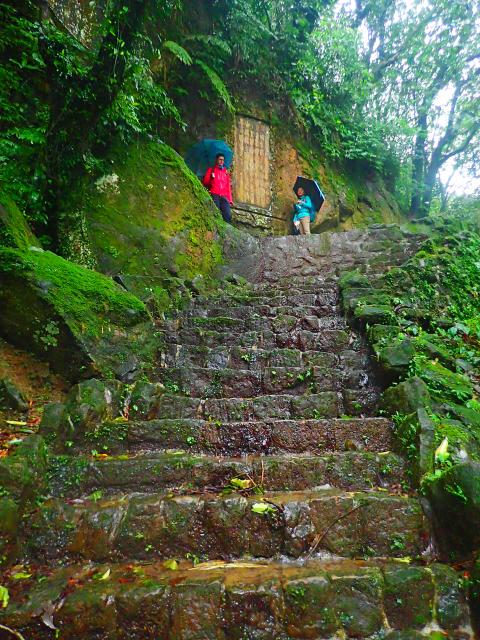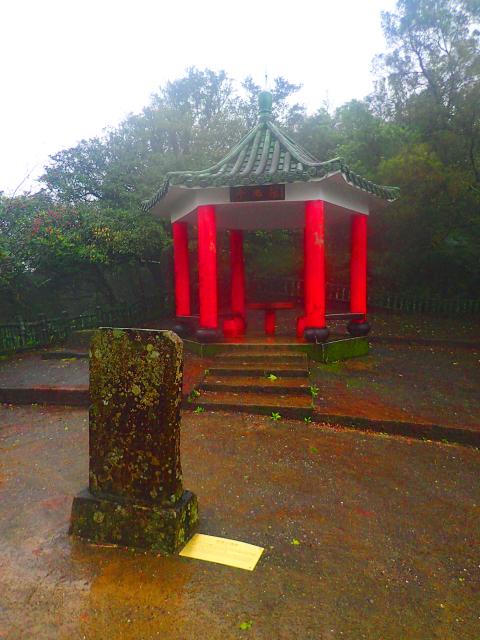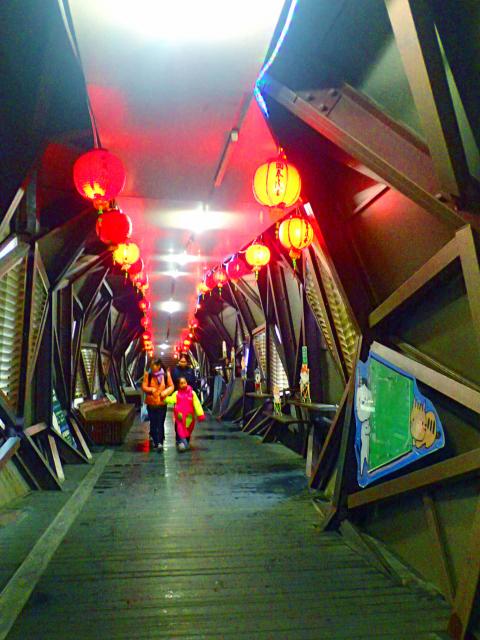It was exactly a century-and-a-half ago, in 1867, that Chinese military ambassador Liu Ming-deng (劉明燈) set off to inspect one of the Taiwan’s newest and most important communication routes.
It was a different world then, of course. Today an inspection would perhaps involve a high-ranking politician taking an inaugural trip on a new Taipei MRT line, accompanied by crowds of camera-toting reporters.
THE OLD DAYS ON DANLAN

Photo: Richard Saunders
Back in the 1860s though, there were no trains of any kind, and no roads either, so Liu’s inspection tour meant a grueling walk of what must have been several days, taking in a section of the crucial Danlan Old Trail (淡蘭古道), which connected Tamsui with the fertile but then hard-to-reach Lanyang Plain (蘭陽平原) in today’s Yilan County.
During his walk, Liu, who was regional commander of China’s military on Taiwan, encountered various hardships, ranging from sickness (the flu) to terrible weather. It seems that people were made of sterner stuff in those days, however, and rather than retreat to lower altitudes when the weather turned nasty (as it so often does in that area of the country), Liu faced the difficulties head on.
At one point, in an attempt to dispel strong gales that were making progress difficult, it is said he brandished a stick dipped in mud, and with a florid movement wrote the character for tiger (虎) on a boulder beside the path. That boulder (and another, much larger inscription a few minutes further along the trail) are now the main attraction (with great views and a magnificent display of blooming silver grass each November and December) along the stretch of the Danlan Old Trail now known as the Caoling Mountain Pass (草嶺古道).

Photo: Richard Saunders
Nowadays, the scenic but often crowded Caoling Mountain Pass is one of the few parts of the Danlan Old Trail that can still be followed, but it’s not the only surviving section of the route. Thanks to a resurgence of interest in Taiwan’s historical heritage in recent years, several sections of the route have been rediscovered and opened for us to retrace, in our leisure, the steps countless long-gone Aborigines and Taiwanese must have trudged a century and more ago.
Three other, less well-known sections of the old route can be followed, all in its southern half. First, the Longling Old Trail (隆嶺古道) is the earliest part of the Danlan Old Trail to be established, and was already being used in 1807. Like the Caoling Mountain Pass, it crosses the mountains of Sandiaojiao (三貂角), in New Taipei City. It’s a short but fairly rough walk, and a good indicator of what the parallel trail might have been like before it was discovered by the masses.
The two other remaining sections of the Danlan Old Trail have, like the Caoling Mountain Pass, both been developed by local authorities for the average walker. First is a short (2km) length of trail following the bank of the Wutu Stream (烏塗溪) from Shiding (石碇) downstream to Provincial Route 106. Most visitors to Shiding are either there to enjoy the town’s famous tofu or to hike the wonderful Huangdidian (皇帝殿) or Bijia Mountain (筆架山) ridges, but this short length of Danlan Old Trail is worth a stroll, despite being accompanied by the elevated carriageways of a freeway for part of its length.

Photo: Richard Saunders
‘GOLDEN LETTERS TABLET’
The last surviving section of the Danlan Old Trail that can be easily followed today is usually known after the main landmark on the route, the third of those impressive inscribed stones carved on the orders of Liu Ming-deng during his eventful survey of the trail in 1867, the Golden Letters Tablet (金字碑).
The trail to the Golden Letters Tablet is a one-hour walk (signposted) from Houtong Train Station in New Taipei City’s Ruifang District (瑞芳), but hikers with their own transport can reach it via the far shorter route from the east, leaving Provincial Road 102 about 7km south of the gold mining village of Jiufen (九份).

Photo: Richard Saunders
Look for an info board beside the road on the right. It’s a short climb up the wooded hillside to a low saddle on the ridge, paved with an ugly expanse of concrete, and an ornamental rest shelter.
In front of the shelter is a well-weathered stone tablet, which looks rather like a tombstone. It is in fact one of Taiwan’s earliest surviving examples of ecological awareness, dating from the same time as the Golden Letters Tablet nearby, and elaborately engraved with calligraphy (now badly eroded) requesting that travelers resting on this spot don’t remove (for firewood) the shade-giving trees that once covered the area.
Follow the steps down the far side of the ridge, and in about five minutes a low outcrop of dark sandstone rises above the path on the left. Carved into its face is an elaborate inscription in the form of a rectangular plaque about two meters high by one wide. This impressive monument is an inscription (originally highlighted in gold, hence the name) etched into the natural rock face on the command of Liu during his 1867 journey.

Photo: Richard Saunders
The verses, in classical Chinese basically implores visitors to enjoy the natural beauty of the scene (“…high and low, watercourses crash like thunder…”), yet be prepared to defend the region from aggression (“…prepare for the future by polishing weapons and recruiting soldiers”).
It’s tough for today’s visitors, with the benefit of modern roads, motorized transport and upgraded paths, to get more than the vaguest feelingfor just how remote this spot would have been when Liu and his retinue passed through a century and a half ago, yet perhaps it’s still possible, within this deep, thick, unspoiled forest, to imagine weary travelers pausing at this impressive monument, resting a moment to read its elegant lines and then passing on their way.
Richard Saunders is a classical pianist and writer who has lived in Taiwan since 1993. He’s the founder of a local hiking group, Taipei Hikers, and is the author of six books about Taiwan, including Taiwan 101 and Taipei Escapes. Visit his Web site at www.taiwanoffthebeatentrack.com.

Most heroes are remembered for the battles they fought. Taiwan’s Black Bat Squadron is remembered for flying into Chinese airspace 838 times between 1953 and 1967, and for the 148 men whose sacrifice bought the intelligence that kept Taiwan secure. Two-thirds of the squadron died carrying out missions most people wouldn’t learn about for another 40 years. The squadron lost 15 aircraft and 148 crew members over those 14 years, making it the deadliest unit in Taiwan’s military history by casualty rate. They flew at night, often at low altitudes, straight into some of the most heavily defended airspace in Asia.

Taiwan’s democracy is at risk. Be very alarmed. This is not a drill. The current constitutional crisis progressed slowly, then suddenly. Political tensions, partisan hostility and emotions are all running high right when cool heads and calm negotiation are most needed. Oxford defines brinkmanship as: “The art or practice of pursuing a dangerous policy to the limits of safety before stopping, especially in politics.” It says the term comes from a quote from a 1956 Cold War interview with then-American Secretary of State John Foster Dulles, when he said: ‘The ability to get to the verge without getting into the war is

Beijing’s ironic, abusive tantrums aimed at Japan since Japanese Prime Minister Sanae Takaichi publicly stated that a Taiwan contingency would be an existential crisis for Japan, have revealed for all the world to see that the People’s Republic of China (PRC) lusts after Okinawa. We all owe Takaichi a debt of thanks for getting the PRC to make that public. The PRC and its netizens, taking their cue from the Chinese Communist Party (CCP), are presenting Okinawa by mirroring the claims about Taiwan. Official PRC propaganda organs began to wax lyrical about Okinawa’s “unsettled status” beginning last month. A Global

Like much in the world today, theater has experienced major disruptions over the six years since COVID-19. The pandemic, the war in Ukraine and social media have created a new normal of geopolitical and information uncertainty, and the performing arts are not immune to these effects. “Ten years ago people wanted to come to the theater to engage with important issues, but now the Internet allows them to engage with those issues powerfully and immediately,” said Faith Tan, programming director of the Esplanade in Singapore, speaking last week in Japan. “One reaction to unpredictability has been a renewed emphasis on